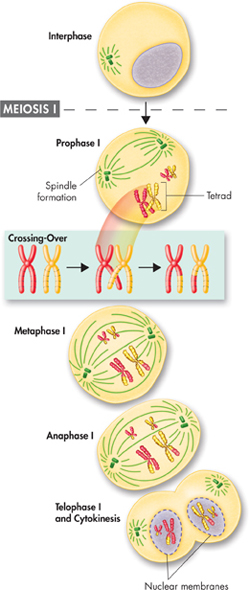Phases of Meiosis
 What events occur during each phases of meiosis?
What events occur during each phases of meiosis?
How are haploid (N) gamete cells produced from diploid (2N) cells? That's where meiosis (my OH sis) comes in. Meiosis is a process in which the number of chromosomes per cell is cut in half through the separation of homologous chromosomes in a diploid cell. Meiosis usually involves two distinct divisions, called meiosis I and meiosis II. By the end of meiosis II, the diploid cell becomes four haploid cells. Let's see how meiosis takes place in a cell that has a diploid number of 4 (2N = 4).

FIGURE 11–15 Meiosis I During meiosis I, a diploid cell undergoes a series of events that results in the production of two daughter cells. Neither daughter cell has the same sets of chromosomes that the original diploid cell had. Interpret Graphics How does crossing-over affect the alleles on a chromosome?
ddMeiosis I Just prior to meiosis I, the cell undergoes a round of chromosome replication during interphase. As in mitosis, which was discussed in Chapter 10, each replicated chromosome consists of two identical chromatids joined at the center. Follow the sequence in Figure 11–15 as you read about meiosis I.
▸ Prophase I After interphase I, the cell begins to divide, and the chromosomes pair up.  In prophase I of meiosis, each replicated chromosome pairs with its corresponding homologous chromosome. This pairing forms a structure called a tetrad, which contains four chromatids. As the homologous chromosomes form tetrads, they undergo a process called crossing-over. First, the chromatids of the homologous chromosomes cross over one another. Then, the crossed sections of the chromatids—which contain alleles—are exchanged. Crossing-over therefore produces new combinations of alleles in the cell.
In prophase I of meiosis, each replicated chromosome pairs with its corresponding homologous chromosome. This pairing forms a structure called a tetrad, which contains four chromatids. As the homologous chromosomes form tetrads, they undergo a process called crossing-over. First, the chromatids of the homologous chromosomes cross over one another. Then, the crossed sections of the chromatids—which contain alleles—are exchanged. Crossing-over therefore produces new combinations of alleles in the cell.
▸ Metaphase I and Anaphase I As prophase I ends, a spindle forms and attaches to each tetrad.  During metaphase I of meiosis, paired homologous chromosomes line up across the center of the cell. As the cell moves into anaphase I, the homologous pairs of chromosomes separate.
During metaphase I of meiosis, paired homologous chromosomes line up across the center of the cell. As the cell moves into anaphase I, the homologous pairs of chromosomes separate.  During anaphase I, spindle fibers pull each homologous chromosome pair toward opposite ends of the cell.
During anaphase I, spindle fibers pull each homologous chromosome pair toward opposite ends of the cell.
▸ Telophase I and Cytokinesis When anaphase I is complete, the separated chromosomes cluster at opposite ends of the cell.  The next phase is telophase I, in which a nuclear membrane forms around each cluster of chromosomes. Cytokinesis follows telophase I, forming two new cells.
The next phase is telophase I, in which a nuclear membrane forms around each cluster of chromosomes. Cytokinesis follows telophase I, forming two new cells.

Table of Contents
- Formulas and Equations
- Applying Formulas and Equations
- Mean, Median, and Mode
- Estimation
- Using Measurements in Calculations
- Effects of Measurement Errors
- Accuracy
- Precision
- Comparing Accuracy and Precision
- Significant Figures
- Calculating With Significant Figures
- Scientific Notation
- Calculating With Scientific Notation
- Dimensional Analysis
- Applying Dimensional Analysis




